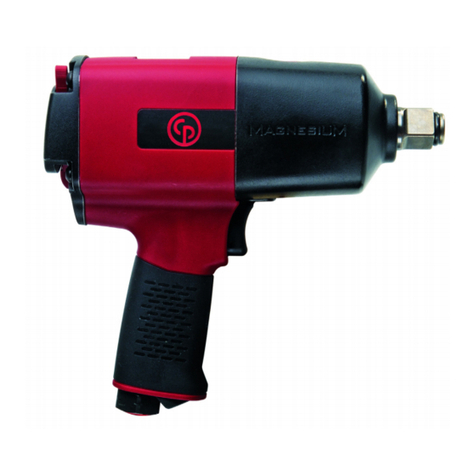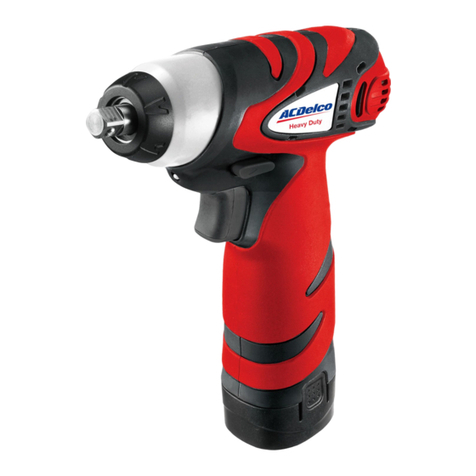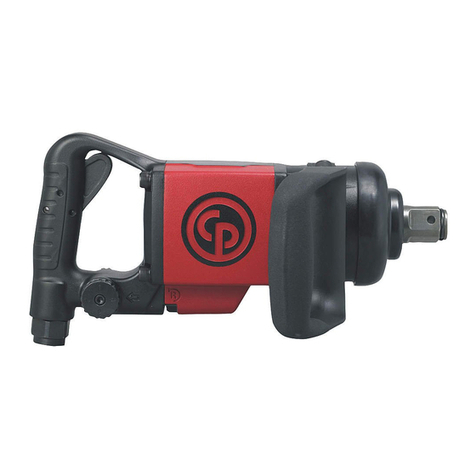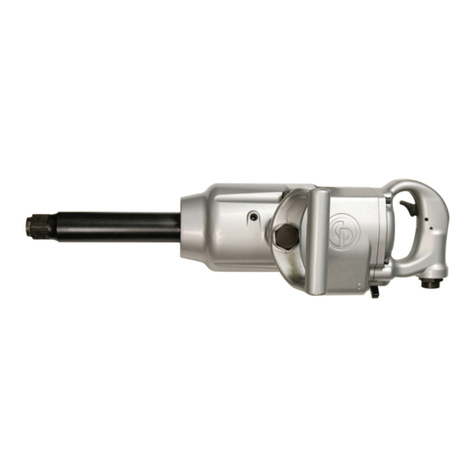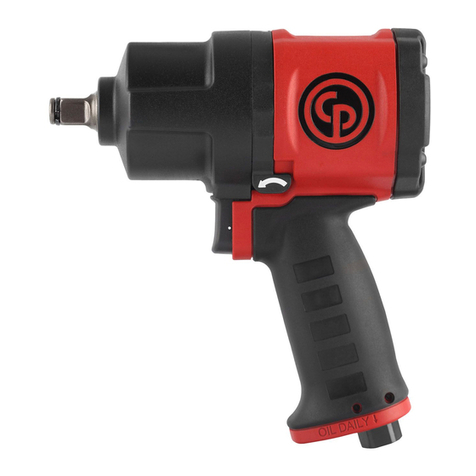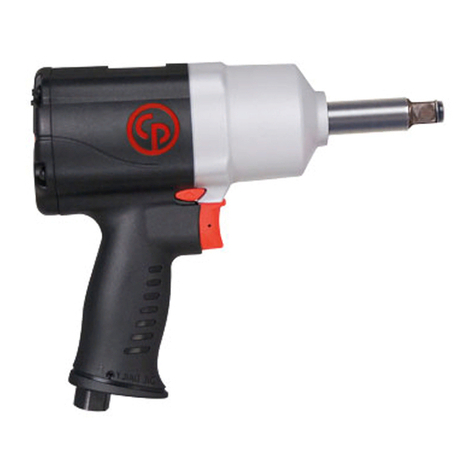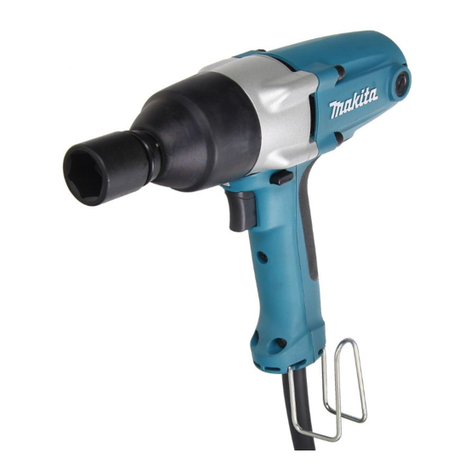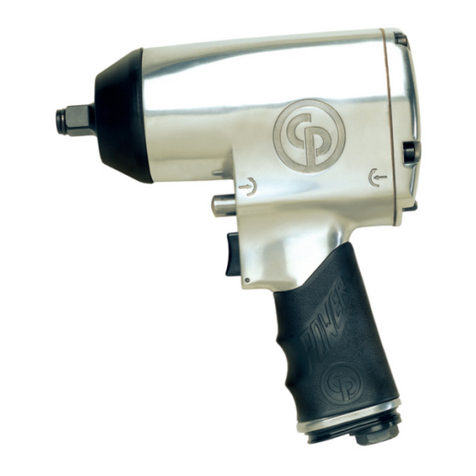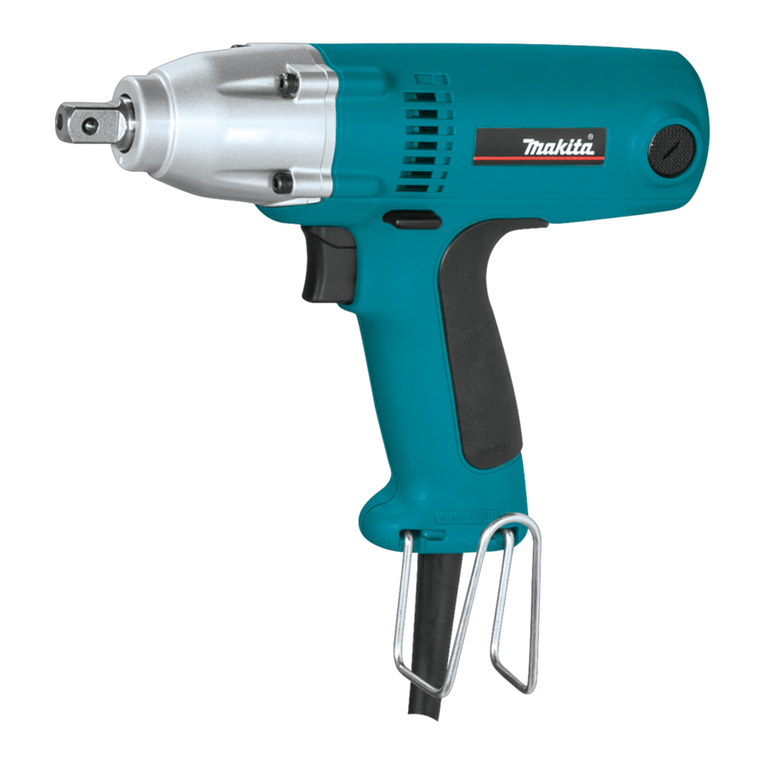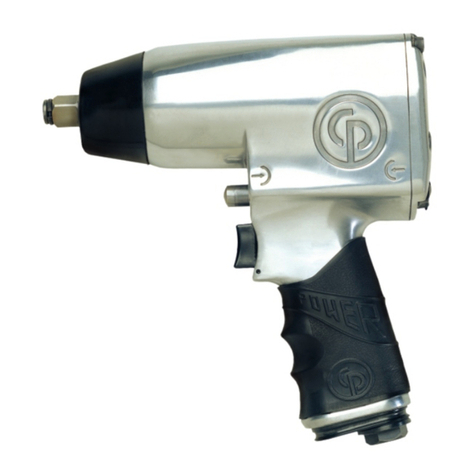10
775-0111A Rev. 03/08/04
LLAVES DE IMPACTO
LA HERRAMIENTA FUNCIONA LENTAMENTE O NO FUNCIONA
EN ABSOLUTO Y / O EL AIRE EMANA SOLAMENTE UN POCO
DEL SISTEMA DE ESCAPE — La causa probable: La corriente
de aire está bloqueada por una acumulación de suciedad; las
partes del motor están atascadas con suciedad; el regulador
de la coriente ha vibrado hacia una posición cerrada.
DEBE: Verifique el colador de la entrada del aire para
detectar un bloqueo posible. Eche una cantidad generosa de
aceite para herramientas con aire dentro de la entrada del
aire. Haga funcionar la herramienta con golpes cortos en
ambas direcciones, adelante y atrás. Repita si es necesario. Si
los resultados de la herramienta no mejoran, debe solicitar
mantenimiento a un centro autorizado de servicio.
HERRAMIENTA NO FUNCIONA Y AIRE DEL ESCAPE EMANA
LIBREMENTE:
La causa probable: Una o más de las valetas del motor está
atascada, a causa de una acumulación de suciedad o barniz; el
motor puede estar oxidado.
DEBE: Eche una cantidad generosa de aceite para herramientas
con aire dentro de la entrada del aire. Haga funcionar la
herramienta con golpes cortos en ambas direcciones, adelante
y atrás. Golpee ligeramente la caja del motor con un mazo de
plástico. Desconecte el abastecimiento del aire. Intente liberar
el motor girando manualmente el mango de propulsión, si es
posible. Si la herramienta está atascada siempre, debe
solicitar mantenimiento a un centro autorizado de servicio.
LOS CASQUILLOS NO SE MANTIENEN SOBRE LA
HERRAMIENTA: La causa probable: El anillo para bloquear
o el anillo blando alternativo del casquillo están gastados.
DEBE: Lleve gafas de protección. Desconecte el abastecimiento
del aire. Quite el viejo anillo para bloquear, utilizando
tenazas al exterior para mantener el anillo para bloquear.
Manteniendo la pieza cuadrada con una llave abierta
apropiada, utilice un destornillador pequeño utilizándolo
como una palanca sobre el viejo anillo para quitarlo fuera de
la ranura. Quite siempre el anillo fuera de su cuerpo - puede
ser propulsado hacia afuera con una velocidad alta. Cambie el
anillo “O” alternativo y el anillo para bloquear con las partes
apropiadas (Vea la lista). Coloque el anillo para bloquear
sobre la mesa, apoye el yunque de la herramienta dentro del
anillo con un movimiento oscilante. Coloquelo a mano con un
golpe en
la ranura.
USO PREMATURO DEL YUNQUE:
La causa probable: El uso de los casquillos de cromo o los
casquillos están gastados.
DEBE: Deje utilizar casquillos de cromo. Los casquillos de
cromo tienen una superficie dura y un corazón blando. El
agujero del casquillo se hace redondo, pero está siempre más
duro. Además del peligro al romperse, los yunques de llave se
gastarán antes de tiempo cuando los utilice con casquillos de
cromo.
LA HERRAMIENTA PIERDE LENTAMENTE SU POTENCIA PERO
FUNCIONA SIEMPRE A TODA VELOCIDAD LIBREMENTE.
La causa probable: Partes gastadas del embrague, causadas
por una lubrificación inadecuada; pisando la leva del
embrague cuando esté gastada o pegada a causa de una
lubrificación inadecuada.
DEBE: PARA LLAVES LUBRIFICADAS CON ACEITE - Verifique
para detectar la presencia de aceite para embrague (donde se
especifica el uso de aceite para el embrague) y quite el tapón
para aceite; inclinelo para drenar todo el aceite de la caja del
embrague ; rellenela con aceite SAE 30 o el tipo de aceite
recomendado por el fabricante en la cantidad especificada.
Verifique también para detectar una cantidad excesiva de
aceite. Las cajas del embrague necesitan solamente un relleno
de 50%. Una sobrecarga puede causar un arrastre sobre las
partes del embrague de velocidad alta. Una llave tipica de 13
mm (1/2”) lubricada con aceite necesita solamente 14 ml de
aceite para embrague. PARA LLAVES LUBRIFICADAS CON
GRASA - Verifique para detectar una cantidad excesiva de
grasa, girando el mango de propulsión manualmente. El
mango debe girar libremente. El exceso está normalmente
propulsado hacia afuera automáticamente.
LA HERRAMIRENTA NO SE APAGA: La causa probable: Un
anillo “O” de la válvula de aceleración está gastado, fuera de
su posición o el eje de la válvula de aceleración está doblado
o atascado con partículas de suciedad.
DEBE: Quite el ensamblado e instale un nuevo anillo “O”.
Lubrique con aceite para herramientas con aire y haga
funcionar el gatillo rápidamente. Si no puede funcionar la
herramienta adecuadamente, debe solicitar mantenimiento
para la herramienta a un centro autorizado de servicio.
TRINQUETES CON AIRE
EL MOTOR FUNCIONA, EL EJE NO GIRA O GIRA DE UN MODO
IRREGULAR — La causa probable: Diente gastado sobre el
trinquete o el engranaje; resorte con presión del engranaje
está frágil o quebrado; resortes de arrastre frágiles no pueden
mantener el eje cuando el engranaje se mueva hacia un otro
diente.
DEBE: Obtiene un reemplazo de las partes, que serán
instaladas por un centro autorizado de servicio.
LA HERRAMIENTA NO FUNCIONA,
LA CABEZA DEL TRINQUETE PUEDE SER MOVIDA
MANUALMENTE CON DIFICULDAD — La causa probable:
Acumulación de suciedad dentro de las partes del motor.
DEBE: Eche una cantidad generosa de aceite para herramientas
con aire dentro de la entrada del aire. Haga funcionar la
válvula de aceleración en golpes cortos. Con el casquillo
pisado sobre la tuerca, apriete y afloje manualmente la tuerca
por otra parte. Si la herramienta está siempre atascada, debe
solicitar mantenimiento a un centro autorizado de servicio.
TALADROS CON AIRE
LA HERRAMIENTA NO FUNCIONA, FUNCIONA LENTAMENTE,
EL AIRE EMANA LIGERAMENTE DEL SISTEMA DE ESCAPE Y EL
EJE GIRA LIBREMENTE — La causa probable: La corriente de
aire está bloqueada por una acumulación
de suciedad; las partes
del motor están atascadas con suciedad.
DEBE: Verifique la entrada del aire para detectar un
bloqueo posible. Eche una cantidad generosa de aceite para
herramientas con aire dentro de la entrada del aire. Haga
funcionar el gatillo en golpes cortos. Desconecte el
abastecimiento del aire. Si los resultados de la herramienta no
mejoran, debe solicitar mantenimiento a un centro
autorizado de servicio.
PROBLEMAS Y SOLUCIONES
REVISE TODAS LAS INFORMACIONES DE ADVERTENCIA, ANTES DE PROCEDER CON EL FUNCIONAMIENTO.
CONSERVE ESTE MANUAL PARA TENER UNA REFERENCIA EVENTUAL.

